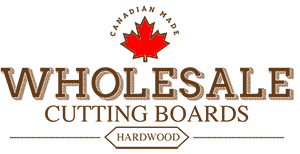Blog
Top 20 Hardwoods for Making Wood Cutting Boards: Janka Ratings, Description, and Usability
For a cutting board, the right cut of wood is very important; it should be hard enough and durable enough, and generally suitable to work with. Every type of wood has its specific Janka hardness rating-a measure of resistance against dents and wear. This article reviews the best 20 woods used in cutting boards for their Janka ratings, description, and usability. Let’s see what type of wood would be beneficial for you.
1. Maple (Hard)
Janka Rating: 1,450
Description: Hard maple is also known as sugar maple; dense, with a smooth, even grain-suitable for cutting boards.
Usability: Hardness imparts durability and the tight grain does not allow bacteria, making it popular to use safely on food processing, including serving as cutting boards.
2. Walnut
Janka Rating: 1,010
Description: Walnut is appreciated for its dark, rich color and straight grain, which makes boards look very luxurious.
Usability: Walnut is softer than maple but boasts really great resistance to shock; it will also remain smooth and won’t cut knives.
Usability: Cherry has a hardness rating that’s hard enough to be durable but soft enough not to dull knives-a great all-round selection for form and function.
4. Teak
Janka Rating: 1,070
Description: There is an oil within teak which makes it resistant in water; the color is that of a rich golden-brown.
Usability: Its hardness and water resistance make it fit for high-moisture kitchens; however, it does tend to dull knives because of the silica content in the wood.
5. Beech
Janka Rating: 1,300
Description: Beech has a warm, reddish-brown look. Possessing a fine, straight grain.
Usability: Due to its hardness and regular texture, it maintains a smooth surface. Friendly to food; highly susceptible to warping if moisture exposure becomes too extreme.
6. Bamboo
Janka Rating: 1,380 (composite rating)
Description: Although bamboo is technically a grass. It is incredibly hard and is a very eco-friendly option with a distinct linear grain.
Usability: It is a very sustainable choice due to its density and renewable growth, though it can crack if not cared for properly.
7. Acacia
Janka Rating: 1,750
Description: Acacia features a deep, dark coloring and different types of grain patterns that add an element of visual interest.
Usability: Acacia is hard and resistant to scratches, but it can also be hard on knives and holds up well under heavy use.
8. White Oak
Janka Rating: 1,360
Description: This traditional wood has an evident, straight grain, with a pale, natural color.
Usability: Its hardness and moisture resistance, especially quartersawn, make it ideal for durable cutting boards.
9. Red Oak
Janka Rating: 1,290
Description: Red oak has a coarse, open grain and a lighter color compared to the white oak.
Usability: Although resistant to wear and tear, its open grain can offer a breeding place for bacteria, so additional cleaning is necessary to keep it hygienic.
10. Ash
Janka Rating: 1,320
Description: Ash displays a light color with other, yet straight grain that adds character.
Usability: Hardness and resilience under heavy use would be acceptable but more porous than some other woods.
11. Purpleheart
Janka Rating: 2,520
Description: Wood of Purpleheart is a really saturated purple color that darkens over time.
Usability: Very durable, extremely hard and tough, but can be harsh on knives; best used with other woods.
12. Mahogany
Janka Rating: 800
Description: Mahogany has a warm reddish color with fine grain.
Usability: Much softer than most of these woods, mahogany is good for decorative or light use boards.
13. Hickory
Janka Rating: 1,820
Description: Light tan to brown color with great contrast in the grain.
Usability: Strength makes it right for heavy-duty boards but too hard on knife edges.
14. Padauk
Janka Rating: 1,720
Description: The deep reddish-orange color of padauk is the most striking.
Usability: Tough and elastic, but somewhat abrasive to knives. Great for those boards made of mixed woods and gives bold, exotic looks.
15. Birch
Janka Rating: 1,260
Description: Light in color with thin grain, birch is smooth.
Usability: Strong and knife-friendly, but has to be oiled regularly to avoid drying.
16. Bubinga
Janka Rating: 2,410
Description: Bubinga has a reddish-brown color.
Usability: Very dense and correspondingly very heavy, it is very durable wood but is correspondingly expensive. Applied to high-class boards.
17. Zebrawood
Janka Rating: 1,830
Description: Zebrawood has a very striking striped pattern.
Usability: Hard and resistant to wear, but its coarse texture is a bit difficult to maintain.
18. Lyptus
Janka Rating: 1,690
Description: Lyptus is a hybrid of eucalyptus, grown for sustainability with a rich red color.
Usability: Eco-friendly and durable but is sensitive to warping so careful maintenance is important.
19. Sapele
Janka Rating: 1,410
Description: Sapele is reminiscent of mahogany.
Usability: Harder than mahogany, it’s suited for boards where aesthetics are a priority.
20. Iroko
Janka Rating: 1,260
Description: With a warm yellow-brown color, Iroko is durable and water-resistant.
Usability: A resilient choice for moist environments, though it may be slightly abrasive to knives.
Each type of wood has its advantages and characteristics that may positively affect quality and durability, each in its own manner. Be it knife-friendliness, durability, or artistic appeal, the hardness and features of these woods will serve to guide and find the type of wood best suited to your culinary needs.
